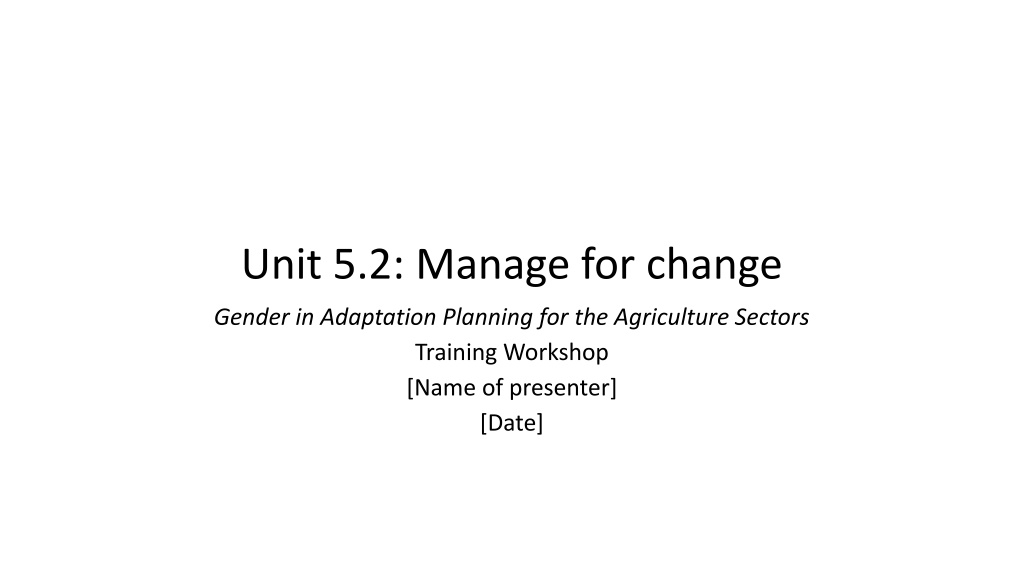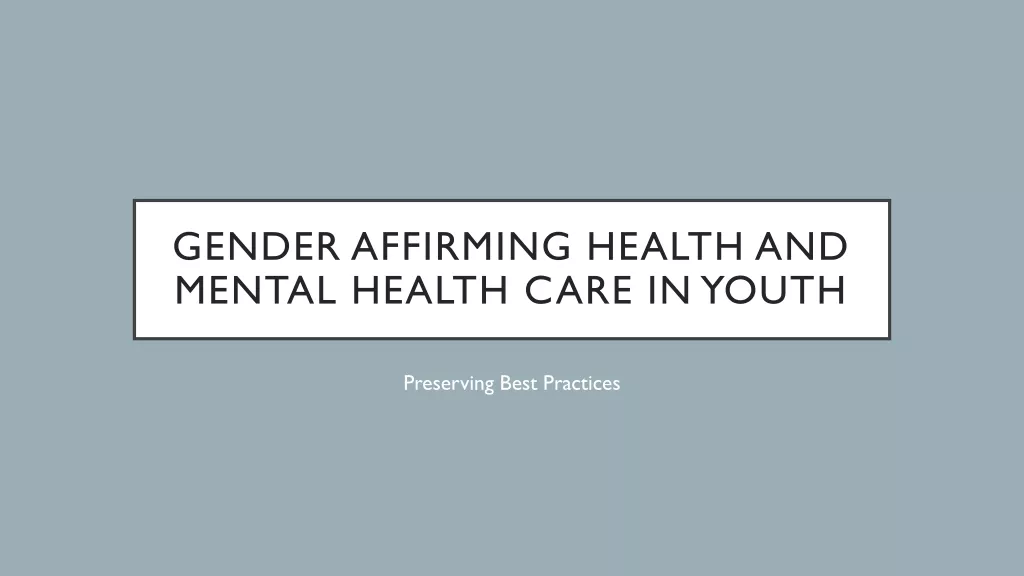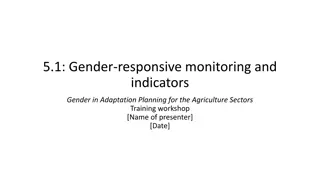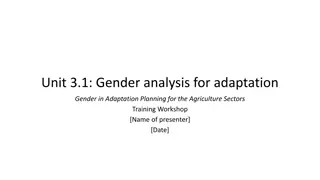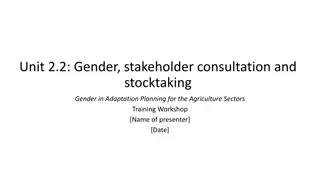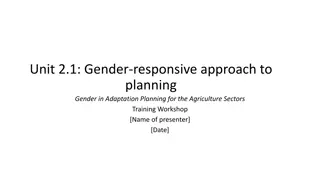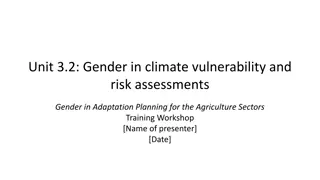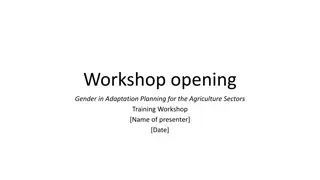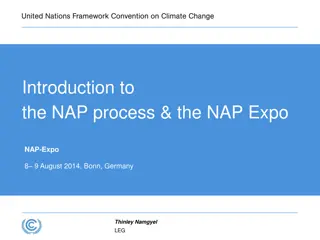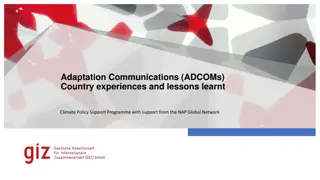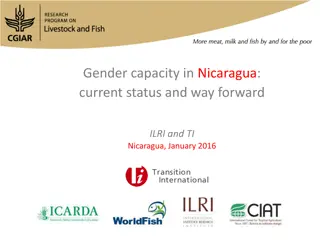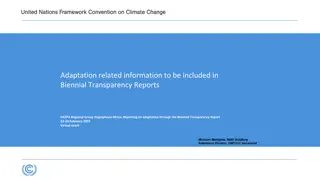Enhancing Gender Capacity in Agricultural Adaptation Planning
Learn how to improve gender capacity in agricultural sectors through individual and organizational development, addressing barriers and enabling factors for gender mainstreaming. Explore the three dimensions of capacity - individual, organizational, and enabling environment - and understand the signs of an organization contributing to gender equality. Key considerations for organizational change to address gender in adaptation include leadership advocacy and overcoming potential challenges.
Download Presentation

Please find below an Image/Link to download the presentation.
The content on the website is provided AS IS for your information and personal use only. It may not be sold, licensed, or shared on other websites without obtaining consent from the author. Download presentation by click this link. If you encounter any issues during the download, it is possible that the publisher has removed the file from their server.
E N D
Presentation Transcript
Unit 5.2: Manage for change Gender in Adaptation Planning for the Agriculture Sectors Training Workshop [Name of presenter] [Date]
Learning outcomes Explain the differences between individual and organizational capacity and identify barriers as well as enabling factors for gender mainstreaming. Explain Set Set goals for after the workshop.
Improving gender capacity The term capacity refers to the ability of people, organizations, and society as a whole to manage their lives and work successfully. Capacity development is therefore the process whereby individuals, organizations and society as a whole unleash, strengthen, create, adapt and maintain capacity over time. Making progress toward gender equality requires improving capacities at the individual, organizational and enabling environment levels.
Three dimensions of capacity Individual capacity refers to skills, behaviours and attitudes among a wide range of actors Capacity at this level is developed through trainings, knowledge sharing, and networking. Organizational capacity refers to the collective capability of members to achieve their goals Capacity at this level is enhanced through measures to improve overall functioning and performance, such as incentives, managerial practices, multi-stakeholder platforms, coordination, and mobilization of resources. Enabling environment refers to the context in which individuals and organizations put their capabilities into action and where capacity development processes take place Capacity can be improved at this level through policy reform, changes to legislation, strategic exercises in country planning and prioritization, or culture changes.
Signs that an organization has the capacity to contribute toward gender equality defines clear gender equality goals defines implementation mechanisms to apply the gender policy to operational systems and work practices monitors and strengthens human resources processes monitors and reports progress toward gender equality objectives, including measurable objectives, indicators and progress markers provides technical and professional advice on gender equality to staff
Key considerations on organizational change to address gender in adaptation Leadership is key: leaders advocate for gender equality, bring in gender expertise when needed, reinforce requirements for collecting sex-disaggregated data and conducting gender analysis, and more Potential challenges: discriminatory norms and practices; misconceptions about gender equality and women s empowerment; lack of understanding of benefits or knowledge on integrating gender; lack of political will; and lack of consistent, comprehensive application of gender-responsive approaches throughout planning process.
Factors that contribute to successfully addressing gender issues in agriculture and climate change plans gender-responsive principles, laws, policies, budgeting; an enabling political and legislative environment at national level, characterized by advocacy by parliamentarians and strong partnerships between actors working on gender equality; organizational capacity within ministries of agriculture and environment to address gender equality making visible women s as well as men s roles and their contributions to agriculture, which is facilitated by the availability of sex-disaggregated data and gender-specific indicators as well as the application of gender analysis in development of policies, programs and projects; and inclusive stakeholder engagement in planning process.
Setting goals: Integrating gender in adaptation planning requires different skills and actions Addressing attitudes and improving knowledge Ensuring a gender- responsive planning process Formulating the plan and gender- responsive budgeting Analysing the problem and solutions Monitoring and managing for change Clarifying values and attitudes around the importance of addressing gender issues in climate change adaptation (Unit 1.2) Improving understanding of basic concepts for integrating gender in agricultural adaptation (Unit 1.2) Promoting principles of good governance (Unit 2.1) Conducting inclusive stakeholder consultation and stocktaking to identify gender- responsive adaptation initiatives and gaps (Unit 2.2) Conducting a gender analysis in the agriculture sector to inform the adaptation plan (Unit 3.1) Assessing gender dimensions of climate vulnerability (Unit 3.2) Prioritizing gender- responsive adaptation options (Unit 3.3) Formulating an adaptation plan document to address gender issues (Unit 4.1) Allocating resources of an adaptation plan using gender- responsive budgeting (Unit 4.2) Monitoring the implementation of the plan using gender indicators (Unit 5.1) Improving gender capacity at all levels plus meeting goals (Unit 5.2)
